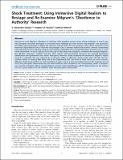Files in this item
Shock treatment : using immersive digital realism to restage and re-examine Milgram's 'Obedience to Authority' research
Item metadata
| dc.contributor.author | Haslam, S.A. | |
| dc.contributor.author | Reicher, S.D. | |
| dc.contributor.author | Millard, K. | |
| dc.date.accessioned | 2015-04-20T09:01:07Z | |
| dc.date.available | 2015-04-20T09:01:07Z | |
| dc.date.issued | 2015-03-02 | |
| dc.identifier | 182343772 | |
| dc.identifier | ed2d4d03-9457-40b8-8547-eeded7006a24 | |
| dc.identifier | 84923884896 | |
| dc.identifier | 000350684900001 | |
| dc.identifier.citation | Haslam , S A , Reicher , S D & Millard , K 2015 , ' Shock treatment : using immersive digital realism to restage and re-examine Milgram's 'Obedience to Authority' research ' , PLoS One , vol. 10 , no. 3 , e109015 . https://doi.org/10.1371/journal.pone.0109015 | en |
| dc.identifier.issn | 1932-6203 | |
| dc.identifier.uri | https://hdl.handle.net/10023/6515 | |
| dc.description | The main work on this paper was supported by a grant from the Australian Research Council to KM and SDR (“Reinterpreting Milgram’s Obedience Studies via Documentary Film”; DP1301108). Additional funding was provided by the Australian Research Council to SAH (“An Advanced Social Identity Approach”; FL110100199) and by the Economic and Social Research Council to SDR (“Beyond the Banality of Evil”; ES/L003104/1). | en |
| dc.description.abstract | Attempts to revisit Milgram's "Obedience to Authority" (OtA) paradigm present serious ethical challenges. In recent years new paradigms have been developed to circumvent these challenges but none involve using Milgram's own procedures and asking naïve participants to deliver the maximum level of shock. This was achieved in the present research by using Immersive Digital Realism (IDR) to revisit the OtA paradigm. IDR is a dramatic method that involves a director collaborating with professional actors to develop characters, the strategic withholding of contextual information, and immersion in a realworld environment. 14 actors took part in an IDR study in which they were assigned to conditions that restaged Milgrams's New Baseline ("Coronary") condition and four other variants. Post-experimental interviews also assessed participants' identification with Experimenter and Learner. Participants' behaviour closely resembled that observed in Milgram's original research. In particular, this was evidenced by (a) all being willing to administer shocks greater than 150 volts, (b) nearuniversal refusal to continue after being told by the Experimenter that "you have no other choice, you must continue" (Milgram's fourth prod and the one most resembling an order), and (c) a strong correlation between the maximum level of shock that participants administered and the mean maximum shock delivered in the corresponding variant in Milgram's own research. Consistent with an engaged follower account, relative identification with the Experimenter (vs. the Learner) was also a good predictor of the maximum shock that participants administered. | |
| dc.format.extent | 466415 | |
| dc.language.iso | eng | |
| dc.relation.ispartof | PLoS One | en |
| dc.subject | BF Psychology | en |
| dc.subject | DAS | en |
| dc.subject.lcc | BF | en |
| dc.title | Shock treatment : using immersive digital realism to restage and re-examine Milgram's 'Obedience to Authority' research | en |
| dc.type | Journal article | en |
| dc.contributor.sponsor | Economic & Social Research Council | en |
| dc.contributor.institution | University of St Andrews. School of Psychology and Neuroscience | en |
| dc.contributor.institution | University of St Andrews. St Andrews Sustainability Institute | en |
| dc.identifier.doi | 10.1371/journal.pone.0109015 | |
| dc.description.status | Peer reviewed | en |
| dc.identifier.url | http://journals.plos.org/plosone/article?id=10.1371/journal.pone.0109015#s10 | en |
| dc.identifier.grantnumber | ES/L003104/1 | en |
This item appears in the following Collection(s)
Items in the St Andrews Research Repository are protected by copyright, with all rights reserved, unless otherwise indicated.

